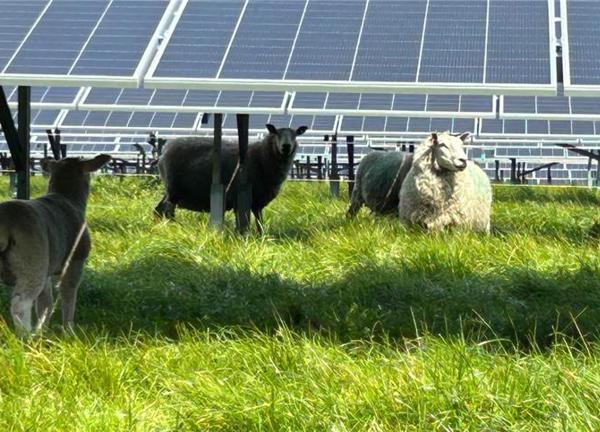Jersey Electricity’s chief executive Chris Ambler said this was a significant moment for local energy production, the Island’s energy sovereignty and the wider community. “This project is an important step forward for Jersey, providing over 4 MWp of home-grown solar power and immediately doubles Jersey’s solar generating capacity. It is in its truest sense a community-based scheme – owned by the Island, through its interest in JE, providing power for the Island.
“Looking at the figures from the testing and commissioning phase, the solar farm generated 482 MWh for March, which is over 30% more than we forecast. As the sunniest place in the British Isles, JE’s solar projects including our seven rooftop sites are consistently performing well.”
The site also heralds a new era for dual land use – farming and energy production – so-called “agrivoltaics”. The solar farm is home to more than 100 sheep from Panigot Farm, owned and operated by Jeremy Hughes. The benefits of grazing sheep around solar panels are well documented with studies showing solar sheep are healthier and happier as they enjoy shade and shelter from the panels – as well as helping to maintain short grass.
Jeremy Hughes, owner of Panigot Farm, said, “Already being aware of the benefits of grazing sheep around solar panels, I approached JE back in 2022 when I first heard about plans for the solar farm. It’s brilliant to see my sheep in these fields today, enjoying the land and panels’ shelter. With access to this land, I hope Panigot Farm will be able to expand and our lamb become a produce that is available to all Jersey people and on more local restaurant menus.”
JE has set the target to build 25 MWp of solar over the next two years. Across six ground-mount solar sites, three of which are already consented, this will power around one third of Jersey’s summer peak electricity demand whilst taking up just 0.6% of Jersey’s agricultural land.
Deputy Steve Luce, Minister for the Environment said, “Low carbon energy will be critical to the Island’s energy mix in the future. I congratulate Jersey Electricity and its partners on developing this scheme which, as well as providing the Island with renewable energy, also helps contribute to our energy security.”
Chris Ambler explained that the benefits cover several important areas. “By bringing this solar power onto our grid, we ensure that everyone in our community can share in the benefits of locally-generated renewable energy. The project delivers against several local policies, including Jersey’s Island Plan, the Carbon Neutral Roadmap and Rural Economy Strategy. Larger projects, such as this, will help to keep electricity costs, and therefore prices, lower and more stable over the 40 years the site generates power. Importantly the land will also now have the opportunity to regenerate, while the site will reap the benefits of environmental net gains and boosted biodiversity. Under the consents given, the equipment will be automatically removed at the end of the planning period and the site restored to bare earth, should that be the wish of the next generation.
“We hope to see Panigot Farm thrive with more local lamb on local menus. We want to see Jersey emerge as a leader in the ‘agrivoltaics’ space, providing a chance for our farming industry to diversify and build on the important traditional crops for which the Island is renowned.”
JE is engaging with farming groups, schools and the wider community to share the benefits of locally-generated solar power. Two classes from St Clement’s Primary School will visit the site this week to learn more about how the electricity generated powers their homes and schools.
“I’d like to extend my thanks to the many partners involved in this project, including over 30 local companies, who have helped in the development and construction of this solar array. The project has provided a welcome economic stimulus for the local construction industry while also developing new green skills which will be important for the growth of the renewables sector,” added Chris Ambler.
Expected year one generation figures:
- Powering 622 average electric homes
- Powering more than 18 million miles in an EV – equivalent to 730 times around the world
- Boiling 66,629,657 cups of tea
- Powering more than 16 million family movie nights
Watch our video






